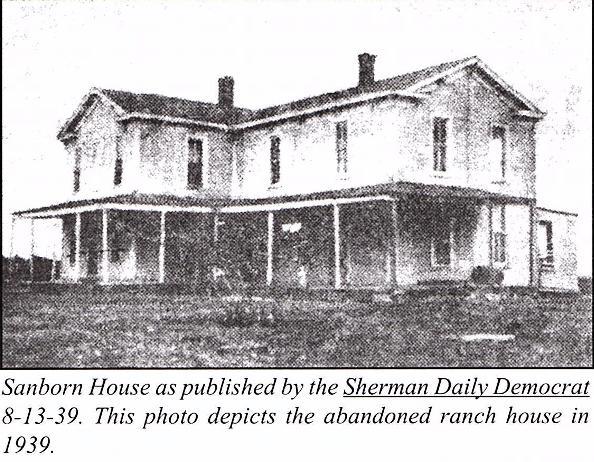 Prior
to the Civil War, Texas was an open-range state. Grass was free but
each rancher claimed grazing rights for as much land as they could
hold. Although they had no title to the land, they enforced their
holdings with six-shooters. By the end of Reconstruction in the
southern states, the free range was being encroached upon by
homesteaders who had legal claim to the land and insisted on fencing
their land to keep out wandering herds of cattle. H.B. Sanborn was born September 10, 1845 in St. Lawrence Co., New York. At a very young age he left home and traveled to Minneapolis to live with an uncle. While there he became a salesman of wooden gutters which his uncle manufactured. While on a selling trip to De Kalb, he met Joseph F. Glidden and lived in a room at the Glidden home for several years. In 1868 Sanborn met and married Ellen Wheeler, Glidden's niece, Approximately twenty years prior to the turn of the century, the Sanborn community was located in western Grayson County. It was a ranch headquarters with buildings and structures around it which evolved into an established town. The Sanborn ranch and the homes around it were called the Sanborn Community. It never had a post office. It appears that the area never developed into more than a ranch settlement that appears to have died out before 1900. The Glidden application patent No. 157724 was granted on November 24, 1874 to Joseph Glidden. Glidden was a relative by marriage of H.B. Sanborn, who he urged to become a salesman for the wire. In West Texas there were large ranches with only a few cowboys to control the large herds of cattle. In 1875, Henry Bradley Sanborn traveled to Sherman, hoping to sell barbed wire to the Texas rancher. It was a difficult sell. He conceived a plan - to purchase in 1877, 2,000 acres ten miles west of Sherman. His land holdings eventually increased to 10,000 acres. He built a large ranch house on this land and fenced it with barbed wire. It was the first large ranch fenced in Grayson County and the State of Texas. It was a horse ranch, a show place and a place were ranchers could see how effective the barbed wire fence was in handling livestock and managing pastures. The plan was so successful that in 1881 Sanborn convinced Joseph Glidden to make a joint purchase of 250,000 acres in the West Texas Panhandle and fence it with a fence for 150 miles of Glidden's barbed wire and stocking the land with 1,500 cattle. This became known as The Frying Pan Ranch. Sanborn brought his Grayson Co. ranch superintendent to the west Texas ranch and put him in charge of building the unprecedented fence. Posts were cut and hauled from Palo Duro Canyon, 40 miles away. On a portion of this ranch developed the town of Amarillo, county seat of Potter County. When others tried to establish the town and county seat at Tascosa, Sanborn bought all of the buildings, moving them and the county records to his ranch. He built and owned the Amarillo Hotel, developed the town's first water works, gave the town 9 acres which he named Elwood Park, and gave 20 acres for St. Anthony's Hospital. Mrs. Sanborn donated land in Amarillo that became Sanborn Park.  By 1883 Texas was experiencing a fence-cutting war between landless cattlemen and landowners who fenced their land with barbed wire. Some ranchers enclosed public lands along with their own land; often these fenced blocked public roads, cut off schools and churches, and interfered with mail delivery. Cutting fences was done mostly at night by armed bands who called themselves "Owls", "Javelinas" or "Blue Devils". On October 13, 1883 Gov. John Ireland called a special session of the Legislature to meet January 8, 1884 to make fence cutting a felony punishable by 1-5 years in prison and malicious pasture burning punishable by 2-5 years in prison. Fencing of public lands was made a misdemeanor and required the removal of the fences within 6 months. At his Grayson Co. ranch, Sanborn is given credit for improving the cow horse by cross breeding thoroughbred horses with mustangs. He developed a string of thoroughbred race horses and harness stallions which he exhibited each fall at The State Fair of Texas in Dallas. Mr. Sanborn donated the land to the City of Dallas where the Cotton Bowl and the State Fair of Texas are held. (Grayson County, Where The West Began by Neilson Rogers, pg74 - 79) Sherman Daily Register Saturday, October 27, 1900 pg.4 PRAIRIE CHICKEN Several Fine Flocks Seen on the Sanborn Ranch. Several fine flocks of prairie chickens have been seen on the Sanborn ranch recently and local sportsmen who can get permission will have some excellent shooting out in this section. Historical Marker Biography Index Towns Susan Hawkins © 2024 If you find any of Grayson CountyTXGenWeb links inoperable, please send me a message. |